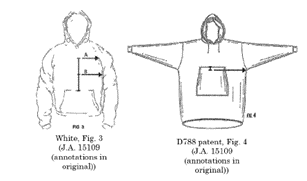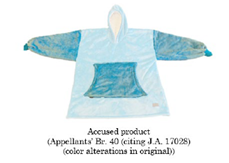The US Court of Appeals for the Federal Circuit recently issued a decision that held for the first time that principles of prosecution history disclaimer apply to design patents, aligning design patent law more closely with longstanding utility patent principles. In Top Brand LLC v. Cozy Comfort Co., the court found that the patentee, through arguments made during prosecution, had disclaimed key features of its claimed design, features that were central to the infringement finding.
Cozy Comfort owned US Design Patent No. D859,788 (D788), which claims “[t]he ornamental design for an enlarged over-garment with an elevated marsupial pocket, as shown and described.” [1] During prosecution, the examiner rejected the claim as anticipated by a prior art design (the “White” reference).
In response, Cozy Comfort distinguished its design from White emphasizing specific differences, thereby, according to the Federal Circuit, disclaiming those aspects of its design. [2] Figures from the D788 patent, White, and the accused product are shown below.


Years later, Top Brand filed a declaratory judgment action against Cozy Comfort, seeking determinations of noninfringement and invalidity of the asserted D788 patent. [3] At trial, however, the jury, having received no instruction about potential disclaimer of claim scope based on prosecution arguments, returned a verdict, in relevant part, that Top Brand infringed the D788 patent. [4] The district court denied Top Brand’s motion for judgment as a matter of law, and entered judgment pursuant to the jury verdict against Top Brand, who appealed. [5]
The Federal Circuit reversed. It disagreed with both the jury and the district court, reversing the district court’s denial of Top Brand’s JMOL motion, broadly holding that the doctrine of prosecution history disclaimer applies to design patents, and specifically holding that Cozy Comfort disclaimed scope of its design patent based on arguments made during prosecution. [6]
In broadly holding prosecution history disclaimer applies to design patents, the Federal Circuit’s reasoning leaned heavily on its 2014 decision in Pacific Coast Marine Windshields Ltd. v. Malibu Boats, LLC. [7]. There, the Federal Circuit held that the applicant narrowed the scope of his original application by “cancelling figures associated with all but one of the patentably distinct groups of designs.” [8] The Federal Circuit saw “no reason to distinguish between disclaimer by amendment and disclaimer by argument and conclude[d] that a patentee may surrender claim scope of a design patent by its representations to the Patent Office during prosecution.” [9]
Because the only similarities between the D788 patent and Top Brand’s product were features that had been disclaimed, the Federal Circuit concluded that no reasonable jury could find infringement.
TAKEAWAYS: ARGUE WISELY, DESIGN STRATEGICALLY
This decision highlights that it is critical to be strategic and deliberate in distinguishing prior art during design patent prosecution, and to think about enforcement of the patent at an early stage, similar to utility patent prosecution. Simply getting a granted design patent may not be enough, and as AI searching tools increase in power, prior art rejections for design patent applications are likely to increase.
The Federal Circuit’s decision here also suggests a more iterative approach to distinguishing prior art. That is, distinguishing the prior art one aspect at a time to minimize any disclaimer necessary to reach allowance.
[1] Top Brand LLC v. Cozy Comfort Co., No. 2024-2191, Slip Op. at 3 (Fed. Cir. July 17, 2025).
[2] Id. at 4-5.
[3] Id. at 5.
[4] Id. at 6.
[5] Id.
[6] Id. at 19-20.
[7] Id. at 9-10.
[8] Id.
[9] Id. at 10.
[View source.]